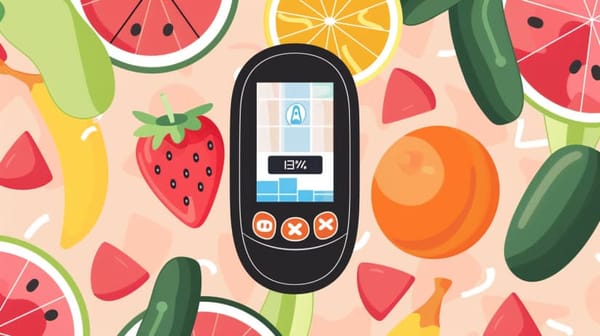You can expect a lot of variation in dry fasting results when you sample different people. Results can vary widely based on age, health, sex, diet, body composition, and more. Your dry fasting experience also plays a big role. My experience after having completed 5, 7, 9, and even 11-day dry fasts affects the amount of weight I lose, my energy levels, and my mental preparedness.
What is Dry Fasting?
Dry fasting, where individuals abstain from both food and water, is an ancient practice with claimed benefits like weight loss, improved immune function, better skin, and reduced inflammation. However, scientific evidence supporting these claims is limited, and the risks may outweigh the benefits. Dry fasting risks include dehydration, mental fog, kidney stones, and urinary tract infections. This practice differs from intermittent fasting, which involves eating and fasting cycles, and water fasting, where only food intake is restricted. Dry fasting has been practiced for centuries for religious and spiritual reasons, but one should exercise caution and seek medical advice before attempting it. Although dry fasting can help improve mood, focus, and mental clarity, it is essential to ease into it and maintain a healthy diet and regular physical activity for overall well-being.
This is an account of my 7 days out of an 11-day dry fast. My diet prior to the fast (not including preparation) was carnivore. I am one of the few dry fasters that experiment successfully with the carnivore diet and dry fasting. In fact, I might argue that I have better results than the other common diets associated with dry fasting that avoid animal products. As I experiment, record, and discuss with others, I'll keep on top of it and keep you updated. I even look forward to experimenting with a fruitarian approach so that I can tell you all about it in the near future. Read more about the diet in the article below.
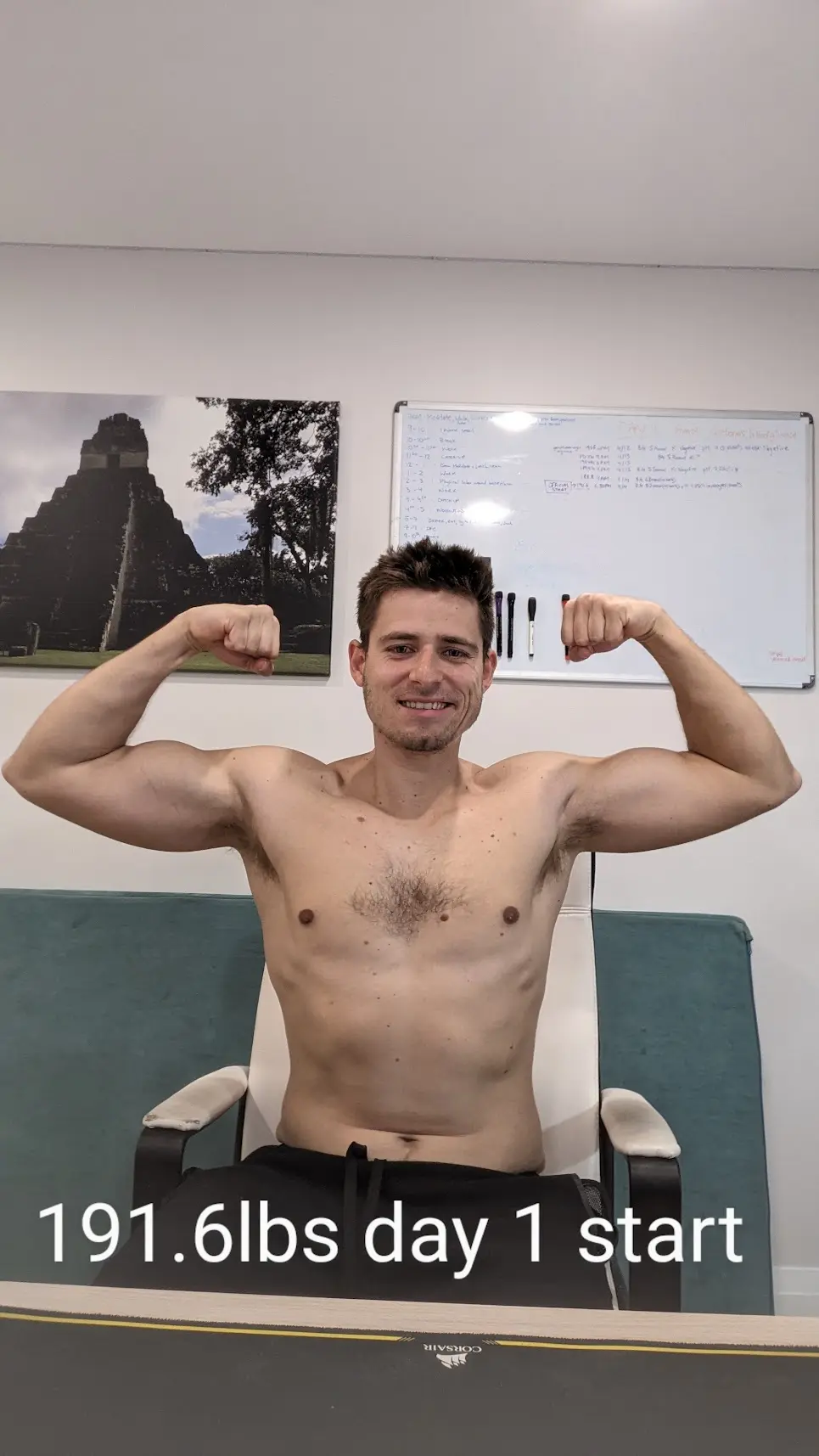

You can find additional details on days 1 to 5 of the dry fast by clicking this link. This post specifically continues and analyzes day 6 and day 7 of my dry fast.

What to expect for weight loss during a 7-day dry fast
The simplest way to look at it is that after you pass the first 2 days, you can expect the following days to drop approximately 1kg or 2.2 lbs per day. The first 2 days can have a huge drop, so keep that in mind. The first 2 days of a dry fast are a lot of water weight being shed during the post-absorptive stage. The first stage drops glycogen and glucose in the body which comes with a huge water and electrolyte drop. Read about dry fasting stages below.
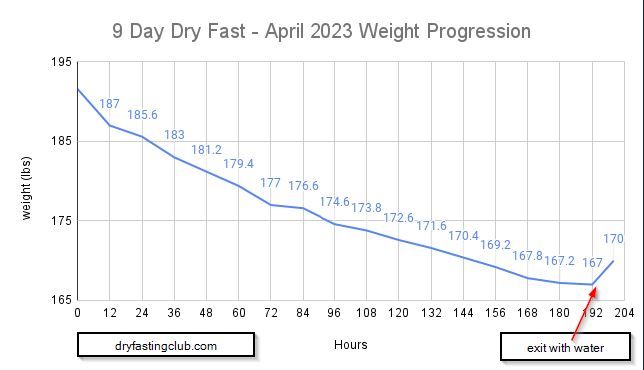
Measurements during a 7-day dry fast
I keep track of most of my dry fasts, and I also advise anyone I work with to keep track. Being aware of your pH values, and GKI can give you amazing insights into where you are in your fasting stage, as well as perfect indicators as to when you should either "emergency exit the fast" or if you are nearing the end of your timeline, when you should "ideally exit the fast" for maximum benefits.
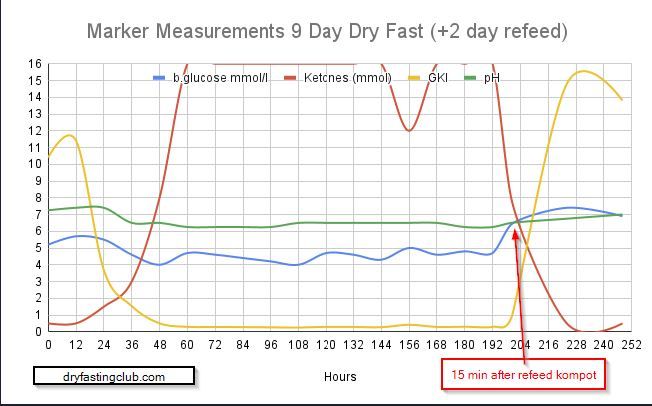

Reasons for different weight loss during a dry fast
Fasting leads to weight loss primarily from eliminating excess food, waste, and fat, rather than essential tissues. In the process, you shed unwanted weight associated with various health issues. Muscle mass might decrease, but this results from reduced fat within the muscles and smaller cell sizes. Studies indicate that women generally lose more weight than men during fasting, possibly due to higher adipose tissue and a lower metabolic rate. Overweight individuals and those who are unwell tend to lose weight more rapidly than healthy or thinner people. Emotional and active individuals also experience faster weight loss compared to calm, balanced individuals. The condition of a person's tissues can also impact weight loss, with those having flabby, soft tissues losing weight more quickly than those with denser tissues.
From my dozens of dry fasts, I have barely lost strength upon returning to working out. Of course, there's some loss, a lot of it from the water loss and overall weight loss. I don't go back to heavy working out during the week or so of initial refeeding, as the body is weak and dehydrated. I haven't been able to measure personal bests. It's very important to work out and exercise lightly and gradually on day 3 and up. Never pushing too hard, but making sure to re-engage the muscles and tell your body that you will be using them. The first days should be mostly walking, with a very gradual increase in physical activity. It takes a few days for the muscles to rehydrate properly. During this time, using a shovel, doing an awkward pushup, or picking up a heavy box can pull something really quickly.
Refeeding is the most important part of the healing process. If you're looking to keep off some weight or heal various illnesses and issues, you will need to be very strict during your refeed. Read more about careful refeeding here.

My Diet prior to the 7-day Dry Fast
Over the last 2 years of dry fasting, I have tried various diets. The Carnivore diet was the simplest for managing symptoms of long covid, so I have become quite familiar with it. The diet I personally prefer, now that I am healed from long covid is an animal-based diet that focuses on fruits and meat. I do see-saw between animal-based and zero-carb keto, based on weight goals and workout goals. And if there's a real urgency, the carnivore diet is the strongest tool. Read about butyrate and why I don't like to drop fiber completely. I love experimentation and believe that there's an optimal way to eat. I still have to try out a 30-day fruitarian diet though, haha.

Even though I eat a lot of meat, I do believe that you need to alter the diet in preparation for a dry fast. There's no doubt that fruits and vegetables are much quicker and simpler to digest for the body, strictly in terms of digestion. Fat is the hardest macronutrient to digest, followed by meat protein. Read more about my preparation protocols under Protocols. Fruitarians and vegans use this information to push the idea that animal foods are unhealthy for the body, but I do not subscribe to this spiritual-based outlook. Currently, the data shows that limiting glucose consumption leads to a longer and healthier life, balancing heavy foods with periodic cleanses and ketosis. There may come a time that I change my mind as the dry fasting journey takes me deeper and deeper, and I'll make sure to monitor my descent into spirituality with the same zeal I use now for a health-based approach to dry fasting ;)
There is a transition from carnivore to keto that should be observed to allow the body to adapt to the fiber transition, followed by the important juice prep protocol. Find my specific prep for this dry fast under the Experiences Tab (under Articles).
The Set Up For 7 days of dry fasting
If you want the best insights into your body. You'll want to perform a blood panel test before your dry fast, and a few weeks after your refeed. You'll also want to spend as much time in nature as possible, walking very slowly, but a lot. Really enjoying being outside, free, and healing. Mental health is arguably one of the most important things during a dry fast that will correlate to how long you will last, how well you will tolerate it, and how much healing will occur. It directly relates to the immune system, cortisol levels, endorphins, and positive thoughts. All of this is strengthened when in nature. Read more about Mental health and dry fasting.
Tests you should take before and after a dry fast for a data-driven approach that helps target your illness without too much shooting in the dark: blood sugar, creatinine flow rate, electrolytes, ALT, lipid assessment, blood cell, iron b12, thyroid pic.twitter.com/cVCBkYen2O
— Dry Fasting Club (@DryFastingClub) April 30, 2023
Temperature: Temperature will be maintained around 21 degrees Celsius. Fluctuations may occur based on heat in the house, which will be counterbalanced with an open window. The outside temperature is currently between 5-10 degrees Celsius. According to Google, the ideal healthy home temperature should be no higher than 20 degrees Celsius or 68 degrees Fahrenheit. However, the living room, bathroom, and child's room should be around 22 Celsius. Because I wanted to be comfortable, 21 felt like a good temperature. The first days of a dry fast can be very cold as anyone who has water fasted knows. However, around day 3, the dry fast accelerates very quickly through the acidotic crisis, into super-deep ketosis, creating a surplus of energy that makes you feel much warmer and more comfortable. Until then, layer up, long johns and double socks if needed.
Humidity: Relative humidity will be maintained around 50-55%. This requires a humidifier to be active on a low level. Humidity can be turned higher or off depending on how it needs to be regulated. 30% and 40% humidity are typically ideal for keeping your home warm and comfortable in the winter, without leaving condensation on the windows. In the summer, that level can be higher, between 50 and 60 percent. There was a slight moisture in the air. This helps a lot during a dry fast and is one of the tricks that advanced dry fasters use to push to higher-level days. You'll notice that people who go for really long always mention being in nature and ideally by a body of water or waterfall. Well now one of the tricks is revealed and you can mimic that situation in your home.
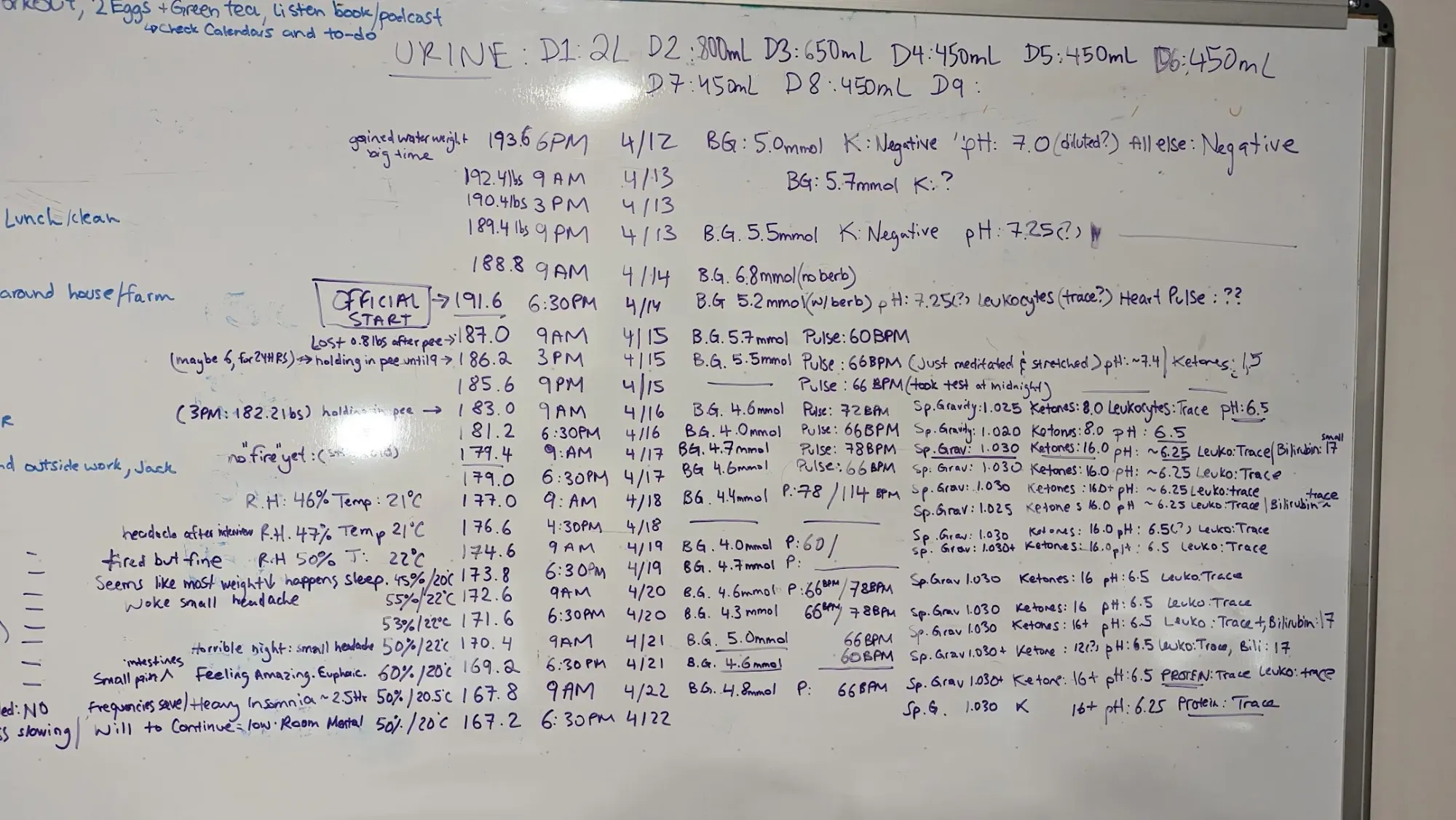
Measuring key markers: Urine levels, urine pH, ketone levels, blood glucose, heart rate, weight, and mental and physical health will be monitored.
Mental Health During a 7-day Dry Fast
Mental health is crucial during a 7-day dry fast, as your emotions significantly impact the fasting experience. Positive emotions, such as joy and gratitude, stimulate the release of endorphins, which act as natural painkillers and mood enhancers. Engaging in activities that promote positive emotions, like spending time in nature or practicing mindfulness, can help you maintain motivation and commitment. Cultivating a positive mindset focused on the benefits of fasting, such as improved health and mental clarity, can enhance your overall experience. By prioritizing your mental health and actively managing emotions during a 7-day dry fast, you can optimize the potential benefits and achieve improved well-being. Read more about the science of Mental health and dry fasting here.
Day 6 of a 7-day Dry Fast
Once you start entering the day 6 and 7-day territory of a dry fast you are doing an advanced dry fast. The normal cut-off point is 5 days where the preparation doesn't have to be taken AS seriously. Even though preparation should always be done correctly, to avoid any complications and to make your experience and healing better. The bare minimum you should be doing is preparing with a speed-run juice prep found here. However, you should be preparing with an intestinal cleanse, healthy food, and topping off on vitamins and minerals that will be required during the fast. Exiting a 7-day dry fast is also crucial. more than 70% of the healing you are looking for is dependent on how well you exit the fast. Think of it like the second part of your marathon. Your cells need the right building blocks, but they also need the right amount of time to rev back up. If you shock them too early, you can expect worse results. If you're doing an advanced dry fast like this you NEED to prepare for both the pre-fast portion and the post-fast portion. Start by reading and understanding one of my refeed protocols - The Omnivore refeed protocol. There's also a carnivore one, but I usually exit with the Omnivore one OR the Filonov refeed protocol variation.

On Day 6 of dry fasting, expect significant thirst and the urge to rinse or moisten your mouth. Sleep may decrease to just 2 hours, and reactions might slow down. Your willpower and determination become vital to continue fasting. You may experience increased self-respect, a heightened sense of smell, and heightened awareness of previously unnoticed scents. Pain in the sacrum and lower back, as well as deteriorating eyesight, may occur. Darker urine signifies the elimination of various salts and ongoing healing. Weight loss typically ranges between 1-2 kg. During Day 6, apoptosis processes intensify. Apoptosis is programmed cell death responsible for maintaining cell population balance and removing defective cells. Dry fasting enhances physiological apoptosis, renewing and rejuvenating the body by eliminating old, sick, or damaged cells. Simultaneously, it helps eliminate pathological apoptosis mechanisms, such as premature aging and oncological diseases. To cope with Day 6's challenges, practice relaxation techniques and perform cupping massages, abdominal, and spinal self-massages in the evening.
Day 6 Dry Fast Personal Update:
Day 6 was fairly simple for me, a little exhausting because of sitting in the room, and because today I had my final dry fasting interview. The day before I had a 3-hour-long interview with FastingwithTrevor, which really took a lot out of me. Today I had a 1.5-hour interview with Arttu about his experience in Montenegro at the Filonov dry fasting retreat. I lost weight according to the regular average of 1kg, and I answered a lot of questions on the live stream.
Why am I doing a 7-day dry fast stuck in a room, and what's the purpose?
You might think it's a bit extreme, but there are several reasons why I've chosen to undertake this challenge:
- First and foremost, I want to demonstrate that a 7-day dry fast is achievable if you're well-prepared, experienced, and possess the mental fortitude to see it through. It's important for me to show that this can be done safely and effectively. I do not recommend doing this as referenced in mental health and dry fasting where it clearly states, long walks in nature have both psychological and physical benefits to you during a dry fast.
- Recently, I was reinfected with possible covid from a friend (long covid fear always in the back of my mind), and this dry fast serves as an opportunity to cleanse my body before any further damage occurs. It's like giving my body a deep clean to help restore my health.
- Surprisingly, I actually enjoy the process of dry fasting. It allows me to immerse myself in the research, explore new insights, and work on my projects without distractions. It's a unique experience that brings me a sense of peace and focus.
- Dry fasting also serves as a dopamine detox for me. Post-fast, I find myself more motivated and energetic, which helps me tackle my goals and live a more fulfilling life. It's like hitting the reset button on my brain, clearing out the mental clutter.
- Lastly, pursuing longevity is a significant motivator for me. Through dry fasting, I hope to slow down the aging process and maintain optimal health for as long as possible. Let's keep aging backward and live our best lives!
Day 6 of 7 Results
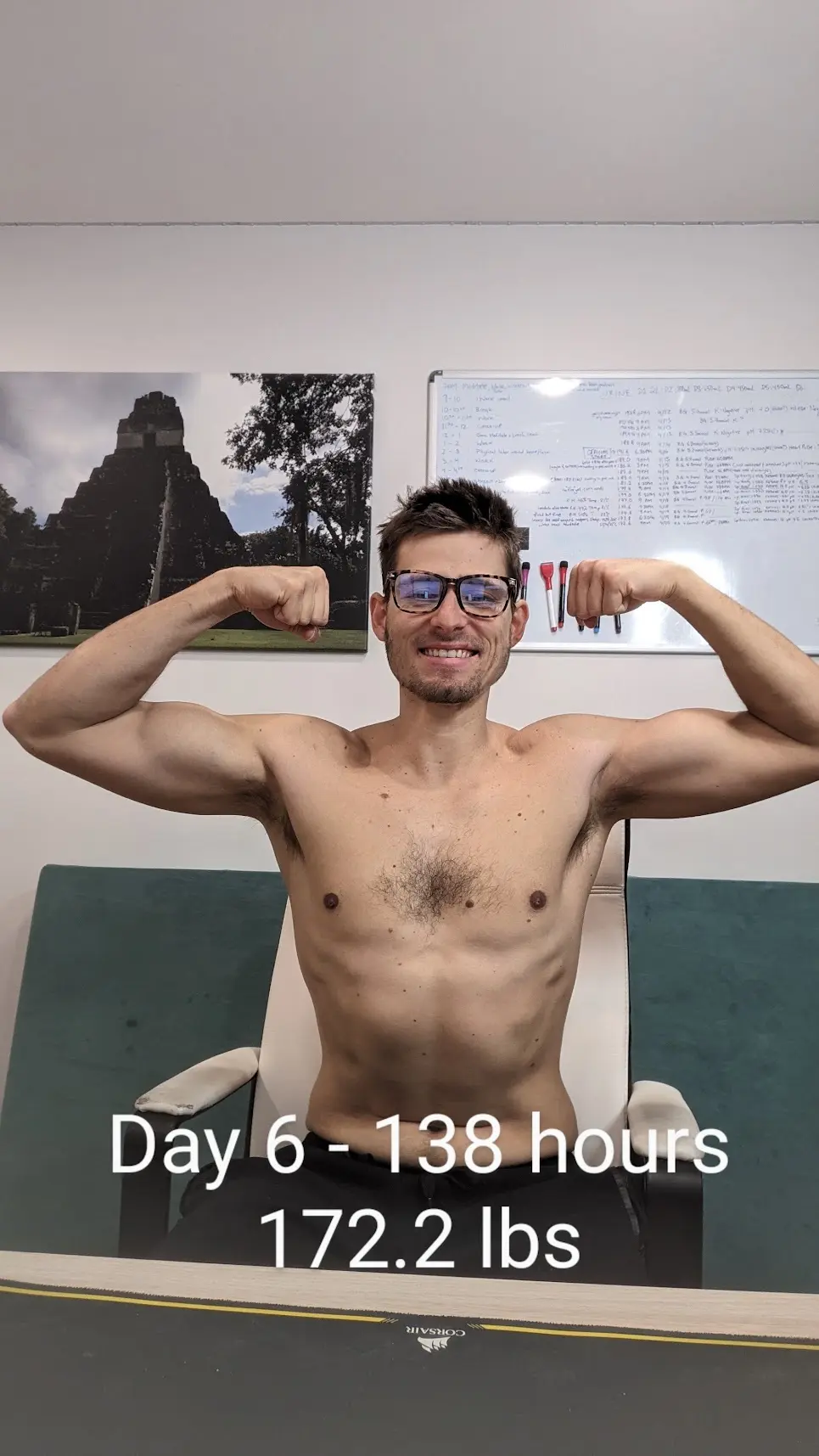

Day 7 of a 7-day Dry Fast
Day 7 of dry fasting is one of the most healing days, characterized by powerful cleansing, energy renewal, and unusual dreams. This process helps cleanse the soul and body of negative energy while strengthening willpower and promoting positive thinking. Additionally, it cleanses chakras and energy channels, resulting in emotional uplift and stabilization of bodily functions. Blood pressure stabilizes, and dark brown urine signifies ongoing detoxification. Morning routines include cupping massage, abdominal, and spinal self-massage, with an average weight loss of 1 kg. During this period, the body replaces old "dead water" with high-quality "live water," which has a unique molecular composition. This process removes negative information and harmful substances that accumulate in the body, rejuvenating it at the cellular level. Dry fasting allows the body to rest and process its own water, leading to the production of endogenous water that is higher in quality than exogenous water. This phenomenon is one of the main healing mechanisms of dry fasting and plays a significant role in renewing the energy balance in the human body.
Day 7 Dry Fast Personal Update:
As I progress into Day 7 of my dry fast, I realize how crucial it is to conserve energy, especially when aiming for an 11-day fast. I've learned that my body can generate metabolic water under the right conditions, so I'm careful not to drain my internal balance by overexerting myself.
On Day 7, I'm feeling the dry fast heat, which makes me comfortable even in cold temperatures. However, I know it's essential to avoid overexercising during this period, as blood becomes thicker and overworking my heart is not recommended. For you beginners out there, make sure you're getting proper sleep, as it's vital for efficient toxin clearance. Sleep in a dark, cool, and humid environment.
Interestingly, today I feel so good that meditation isn't necessary, but I plan to incorporate it during later days. I've been adjusting to the optimal temperatures for sleep and work, as well as finding the right balance between exercise and rest. Keeping myself occupied with editing videos and other projects helps me while confined to my room.
I've noticed that my body is becoming more efficient at buffering pH levels, as there's a slight increase in my pH. This change indicates that my body is preparing for the second acidotic crisis, which is crucial for promoting chaperone-mediated autophagy and speeding up microtubule and hyperosmotic healing. For those of you just starting, be prepared for these changes as they're essential for the healing process.
By Day 7, I've experienced significant weight loss, and some of you may lose up to 20 lbs as well. Overall, dry fasting can lead to immense benefits, and I'm eager to share this knowledge with you to help prevent and treat various illnesses.
Day 7 of 7 Results

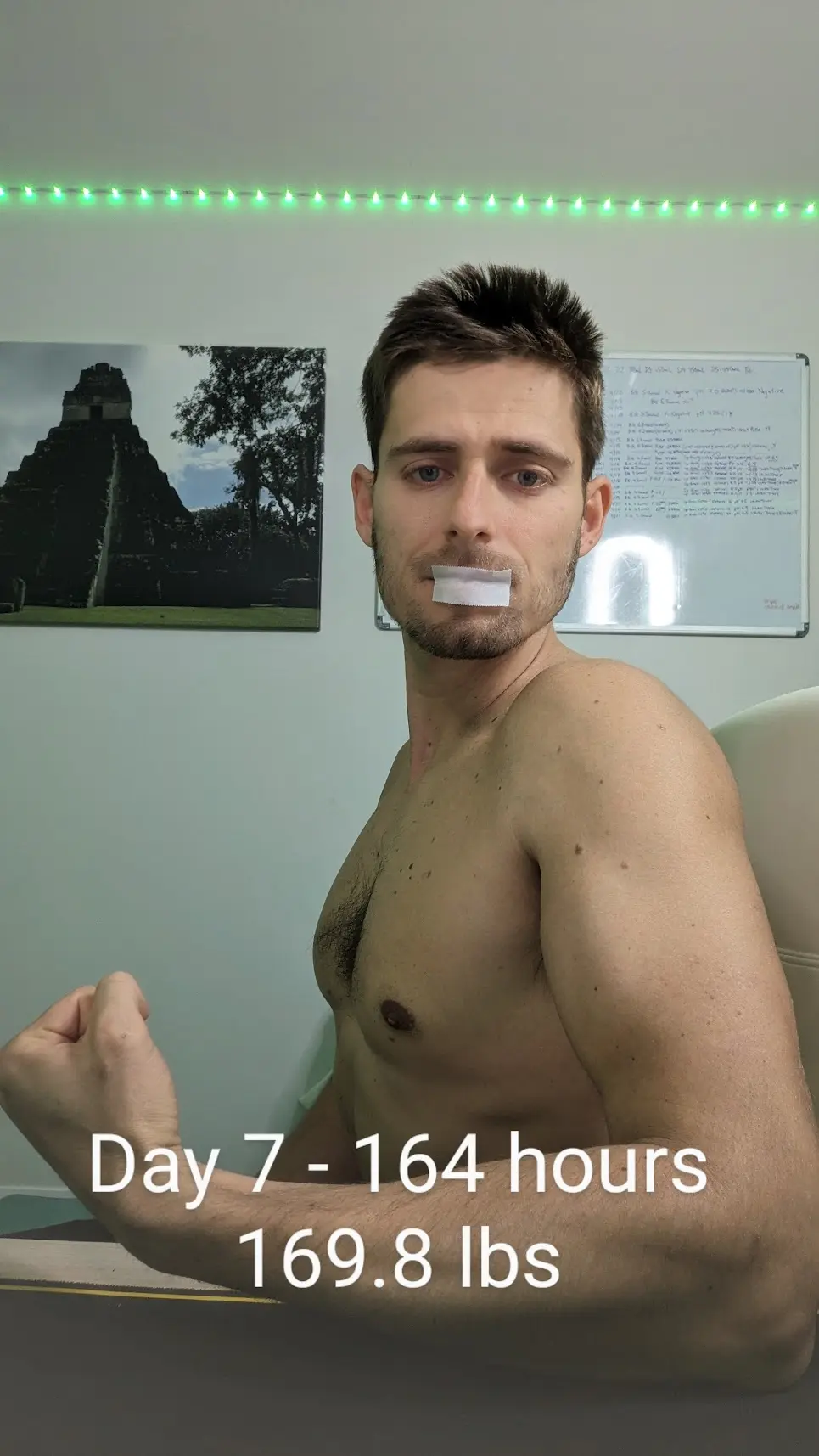
Final Results of a 7-day dry fast
You can see that I started at 191.6 lbs and ended at 169.8 lbs after 7 days for a total weight loss of 21.8 lbs. Wow. That's a big number, but you have to be aware that more than 50% of that is water loss, and you can easily gain back up to 8 lbs of strictly water weight when you finally break the 7-day fast. Also remember that once you pass the 48-hour mark of the post-absorptive phase of ketosis, you are burning much more fat. So the longer you go past 48 hours, the more your fat burn per hour average is increased. It's crucial that you do not take in any sodium for the first 3 days, because your body has upregulated its renin-angiotensin-aldosterone system response and will hold on to every single sodium molecule, and with it, water. So if you don't want to bloat up like a whale, KEEP AWAY from the sodium. You will naturally get minimal amounts of sodium through a healthy slow refeed of things like coconut water, steamed vegetables, and broth (just make sure you get the no added sodium broth). You can look under protocols for some ideas on how to refeed. I have used each of those protocols at different stages of my dry fasting journey, and I continuously update them. Keep an eye out for updated versions. The most recent one I did was a very intricate refeed that follows our good friend Dr. Filonov from Russia's refeed protocol. Click here or below to see my breakdown of Filonov's refeed with a variation included.
Remember, if you want to see the progression pics and insights from day 1 to day 5, click here.




